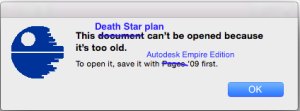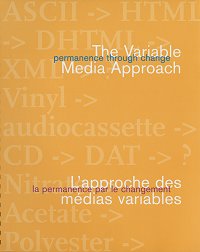 Reinterpretation as a preservation strategy has been called “radical” and “dangerous,” yet this unconventional approach has seen a surge of interest in preservation communities in the past year. In a departure from conventional wisdom about conservation, a group of European preservation experts recently invited Still Water’s Jon Ippolito to reassess this controversial technique as a mainstream model for conserving cultural heritage.
Reinterpretation as a preservation strategy has been called “radical” and “dangerous,” yet this unconventional approach has seen a surge of interest in preservation communities in the past year. In a departure from conventional wisdom about conservation, a group of European preservation experts recently invited Still Water’s Jon Ippolito to reassess this controversial technique as a mainstream model for conserving cultural heritage.
Reinterpreting an ephemeral or obsolete artwork means remaking it from the ground up, sacrificing fidelity to the original material in favor of fidelity to the original spirit–or, at times, to the aesthetic possibilities of a new artwork. Despite the skepticism and anxiety expressed by some in the library and archive communities, reinterpretation may just be the instrument behind the next big wave of cultural stewardship, as emulation has been in the last decade.
In February Ippolito presented themes from his recent book Re-collection in two related events in the Netherlands focused on reinterpretation as a preservation strategy. The UNFOLD working group in Amsterdam and the symposium FUTURE PROOF?! in Schiedam were both organized by Gaby Wijers with Lara Garcia Diaz and Christian Sancto of the LIMA media arts foundation. UNFOLD takes as a point of departure a fourfold scheme for describing preservation strategies outlined in Ippolito’s introduction to the 2003 book Permanence Through Change. Along with storage, migration, and emulation, the essay “Accommodating the Unpredictable: the Variable Media Approach” describes reinterpretation as “a dangerous technique when not warranted by the artist, but it may be the only way to recreate performed, installed, or networked art designed to vary with context.”
The organizers of the UNFOLD working group turned this characterization on its head by positioning reinterpretation not as a strategy from the radical fringe but as the central dynamic of renewing cultural memory. As the group’s final report argues:
Reinterpretation has a great potential not only to activate collections and archives but also to unfold creative and curatorial processes. Moreover, through the act of reinterpreting, new audiences could use the art institutions and the museum as a platform of debate and discussion. Here, the capacity of reinterpretation to rethink, rearticulate and recontextualize artistic thought would allow for the exploration of the past from the present that equally questions our contemporaneity and devises other possible futures.
Examples presented in the Dutch conferences included Joost Rekveld‘s reconstructions of analog video hardware and performances by pioneering video artists Steina and Woody Vasulka, Seppo Gründler‘s miniature versions of famous artworks, and Florian Kramer’s only partly tongue-in-cheek recommendation that films be saved for posterity as paper flipbooks. The assembled experts came from the worlds of theater, music, and other performance genres, breathing new perspectives into the sometimes inbred world of digital preservation. Composer Elisabeth Schimana argued that musical scores are an extension of oral culture and challenged the audience to consider how analogous software is to a score (as proposed by Re-collection co-author Richard Rinehart. Dramaturge Fransien Van Der Putt, meanwhile, explained how reinterpretation is the natural default for theater, where nothing besides the script–no clothing, furniture, and certainly none of the actors–is kept from one staging to another.
 The three other strategies described in Permanence Through Change have by now become familiar to anyone working in variable media preservation. Storage is the default preservation strategy that comes to mind to most lay practitioners, and some professionals as well. But storing a digital file on a magnetic tape or disk drive does nothing to prevent the eventual obsolescence of its software and hardware, from video codecs and web formats to floppy disks, CDs, and USB drives. Migration is another strategy that can be used to preserve documents and files by moving them from one format to another. While a common standard in analog audio and video preservation, migration can be less effective for digital files, which often depend on layers of software and hardware context that are difficult to update along with the audio or video itself.
The three other strategies described in Permanence Through Change have by now become familiar to anyone working in variable media preservation. Storage is the default preservation strategy that comes to mind to most lay practitioners, and some professionals as well. But storing a digital file on a magnetic tape or disk drive does nothing to prevent the eventual obsolescence of its software and hardware, from video codecs and web formats to floppy disks, CDs, and USB drives. Migration is another strategy that can be used to preserve documents and files by moving them from one format to another. While a common standard in analog audio and video preservation, migration can be less effective for digital files, which often depend on layers of software and hardware context that are difficult to update along with the audio or video itself.

Emulation, a third strategy mentioned in Permanence Through Change, describes a newer medium impersonating an older one. This is especially useful for computer programs, because an emulator can run original code for a platform that’s now obsolete, such as the Atari, on contemporary hardware, such as a Mac Pro. Nevertheless, up until the 2010s emulation was considered by most archivists to be too arcane or technologically complex for practical preservation. That changed around 2013 when testbeds such as the exhibition Seeing Double and the initiative Preserving Virtual Worlds testified to the value of emulation in efficiently capturing salient properties of digital works. The turning point was a report from the Preserving.exe conference organized by the Library of Congress that “emulation may serve our needs better than hardware.”
Given the excitement expressed over reinterpretation in the Netherlands this past year, it’s hard not to see parallels with emulation. UNFOLD’s organizers conclude:
Indeed, from the initial question (Can reinterpretation as a creative act be seen as preservation strategy?) we have perhaps arrived to its inversion, can preservation be understood as a creative act and therefore include reinterpretation as one of its strategies?
Now that emulation has found acceptance among mainstream preservationists, reinterpretation may be the new kid on the block.

